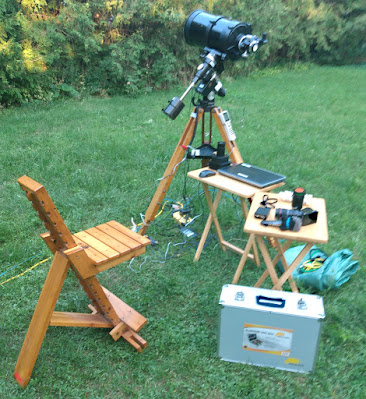Telescope was set up, with an eyepiece. Camera ready. Computer ready. I had let Andrew know I had a good hardline internet connection from the yard. The loaner coupler did not work—maybe it is not a full 8-wire unit. Had to use my old no-name hub/switch to bridge two long ethernet cables together. Weird. I thought it was dead... Working fine. Whew!
Humid.
Checked conditions, Clear Outside and Good To Stargaze. Dew point was predicted at 15°C. It was 25; it would be 15 at 4? It would be at 19 at 1:00 AM so probably I wouldn't need to worry about active heating. Good. Keeping it simply. Already had a lot of wires!
8:11. Retrieved the netbook and some water. And another counter-weight.
Rhonda popped out for a bit while a cardinal trumpeted. We pondered the bizarre locations that squirrels were hiding their nuts. We avoided the murderous tree in the back corner.
Decided to take some screen snapshots of SkyTools running in Real Time mode via ASCOM while controlling the mount through the IDEA GoToStar motor drive system. For the evergreen GoToStar page... Powered up the mount, skipped alignment, turned on tracking, and slewed to Polaris (or thereabouts). Grabbed a half-dozen shots. Slewed again.
As I mounted the camera, the mount fell or pivoted forward! Whoa! Scared me! The altitude axis was lose! Grabbed the Allen key from the case and secured things. Sheesh! Wouldn't not have been good on show night...
Balanced the mount, as best as possible. It is so heavy in the butt when the big MallinCam and the doubler are attached.
Waited for some stars to appear.
Did a proper two-star alignment. Ha! First suggestion was Albireo! I'll see you later. Off to Alphecca.
Back to Albireo. Pointing was off a little.
8:52. Phone rang! Weird... Was in the thick of it so had to let it go to voice mail...
9:01. Slewed to Vega. Installed the camera with the Tele Vue 2x PowerMate.
9:05. Tried to get something on the camera. I was sure I was out of focus. I had no idea what settings to use on the MallinCam. Did a 3 minute exposure. Had the gain high. Set gamma every which way. Oh! When really low, I saw it, the big donut. Focused the SCT by moving the primary mirror. Collimation looked good! Yeh. Balanced gain and gamma. Noted drifting, to be expected—I was not formerly polar aligned. Overshot the focus. Tried to centre the star and almost lost it. Dropped exposure from 3 to 2 seconds while the neighbour's dog freaked out and a firetruck peeled through town.
Rhonda returned. She tagged the Summer Triangle. She asked about our meteor tally. I shared Richard's amazing meteor count, 10 times our numbers. The advantage of being away from the awful light pollution.
I continued to work the focus, now on the Williams Optics. I had no idea what camera settings were best.
Synced on Vega. Slewed to Albireo. Nothing... Panned over using the finder.
The mount protested at one point... motor overload?! "Overcurrent." I ignored it and carried on.
9:23. Recorded video of Albireo. Nice colours. All video was produced by the MallinCam Universe software, the new version.
Reported to Andrew it was working.
All image frames grabbed from VLC. Best frames manually selected. All images, north is left, east is down.
Albireo aka β (beta) Cygni. Round one.
Increased the exposure to 5 seconds and I immediately saw trailing.
Reviewed the MallinCam Universe settings:
- gain: left, 6.8
- contrast: left, 16
- gamma: left, 17
- exposure: 5.2 seconds
Contrast to the extreme right made the stars look bloated with hard edges.
Did a quick polar alignment putting Polaris in the centre of the reticule. Close enough. Put the OTA back on Albireo.
Moved the gain to the middle. It did brighten the stars. Then all the way to the right. It did bloat the bright stars but I could see other stars, w00t! Decreased the exposure to 3.2 seconds.
This was better:
- gain: far right, 26
- contrast: far left, 16
- gamma: far left, 17
- exposure: 3.2 seconds
- histogram: full
Other stars visible. It minimised the effects of drift.
Gamma at the far right may the stars look weird and lose all colour.
9:27. Andrew told me to share so I looked in Evernote. Launched the OBS Ninja link.
9:39. Asked Drew if it was coming through.
- histogram: full
- gain: far right, 26
- contrast: far left, 16
- gamma: far left, 17
- exposure: 3.2 seconds
- saturation: 2/3rd the way to the right
- sharpening: off
- noise reduction: off
It looked good. Gold stars. Double HD 197913 aka STF 2725 is visible at the far right.
10:11. Andrew saw the change, asked what we were looking at.
I wondered about better settings...
Focus was off a bit. Two ticks clockwise. Oh. Better.
10:17. Hey. I noticed Jupiter was visible, clear of the trees, above the notch. And Saturn would be soon. So I could do planets, if need be. Except it is "end of the event."
Considered other doubles. Reviewed my suggested targets in Evernote. Slewed.
61 Cygni, round 1.
10:31. Binned 2 by 2. Neighbouring stars visible.
The E star of 61 Cyg aka STF 2758, orange, is near the top-right, bright. Amplifier glow visible at the top-left.
eta Cas was not possible, given the time. Didn't feel like chasing down epsilon Equ.
Went back to gamma Del. Then bounced around the head of the dolphin. Nope, none of the other doubles were better.
10:43. Told Andrew I was gonna tear down.
One more.
Ugh. Way off target... Did I hear gear hop?!
Alfirk aka β (beta) Cephei.
10:47. Set to 1 second exposure.












No comments:
Post a Comment